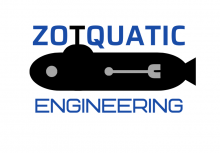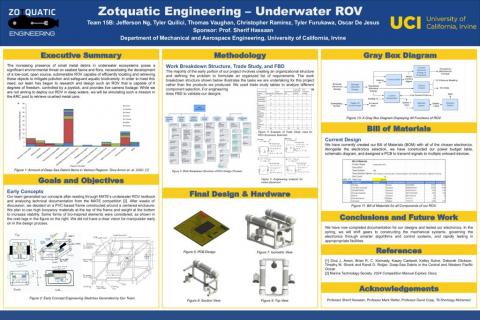Zotquatics Engineering
Summary:
The unique task of working underwater poses new challenges in communication, power distribution, buoyancy, water tightness, motor control, and pressure hull strength. ZotQuatics Engineering seeks to overcome these challenges by designing and manufacturing a low-cost, open-source ROV capable of search and recovery of metal debris in the Anteater Recreation Center swimming pool. More specifically, our ROV will have 4 degrees of freedom, a manipulator, live camera footage, will be able to submerge to a depth of 10 feet, and will operate for at least 20 minutes per run. We are designing the ROV because of the growing ocean pollution problem. Although this ROV is not meant for deep sea applications, the knowledge we gained from this project will help us contribute to future projects that are related to the issue and potentially start a MATE team here at UCI.
Background:
Due to the rise in ocean pollution following the rise of industrialization, the need for remotely operated underwater vehicles has never been greater. Inspired by the MATE ROV Competition, our team aims to develop a low-cost, open-source Remotely Operated Vehicle to tackle the environmental threat posed by small metal debris in our underwater ecosystems.
Goals and Objectives:
Main goal: Search & Recover Underwater Remotely Operated Vehicle
Main objectives:
- Have 4 degrees of freedom (forward movement in the X, Y, and Z axis and rotation around the Z axis)
- Have a manipulator that retrieves an object
- Provide live camera footage through a tether cable
- Capable of operating for at least 20 minutes underwater per run
- Must be remote-controlled.
Subsystems:
Structural subsystem: The structural subsystem is composed of the PVC frame and electronics compartment. The overall purpose of this subsystem is to house the electronics, provide structural support, and ensure neutral buoyancy. This team is expected to conduct drag, buoyancy, and structural analysis.
Propulsion subsystem: The propulsion subsystem is in charge of choosing motors and designing motor placement. Free body diagrams and force equations must be documented to calculate the velocity and acceleration of the ROV at any time.
Electronic subsystem: This subsystem is in charge of designing the circuit that includes voltage regulators, microcontroller, motor controllers, and camera. The subsystem needs to ensure signal and power are delivered to different devices. Communication between sensors and microcontroller must also be well established through the I2C bus. This subsystem is also in charge of creating a Printed Circuit Board(PCB) to ensure the organization of electronics.
Retrieval subsystem: The retrieval subsystem is in charge of designing a manipulator to capture an underwater object. We are not limiting our retrieval mechanism to a traditional robot arm. Instead, it can have any simple mechanism that can accomplish the task.
Power subsystem: This subsystem is responsible for generating and transmitting electrical power from the surface (topside) to the ROV (bottomside). It includes the battery located topside to supply power and the tether that connects to the ROV. As safety is a focus of this project, all power will be stationed away from water for risk management purposes.
Control Subsystem: This subsystem is in charge of implementing feedback control to the system based on sensor reading and programming motor control into the system. The sensor on board includes an inertial measurement unit which can provide orientation and acceleration data to the microcontroller. The control subsystem will use this information to adjust the motor power output to ensure the balance of the ROV.
Team Contact:
Jefferson Ng
Sponsor Contact:
Professor Sherif Hassaan


